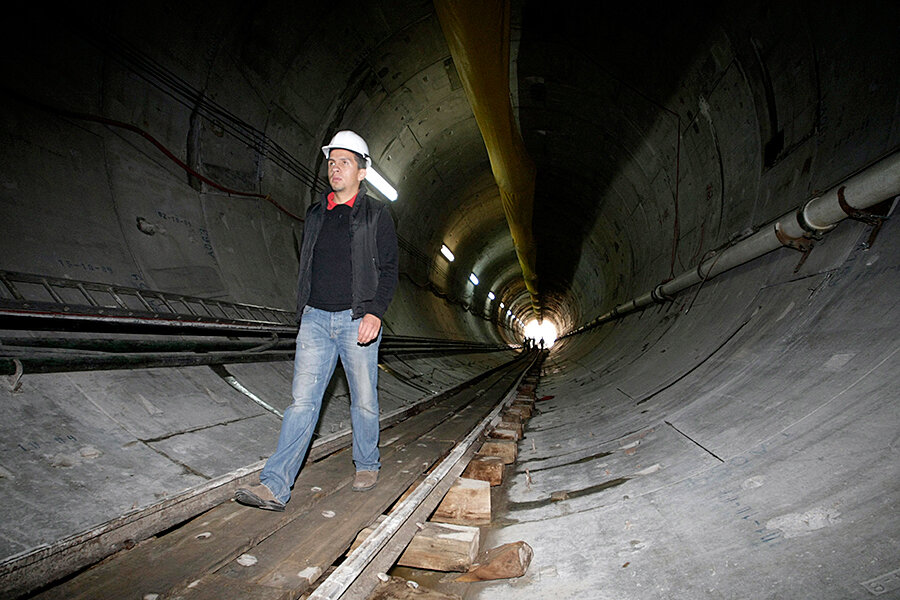In Mexico's thirsty capital, a renewed focus on recycled rainwater
Loading...
| Yugüelito, Mexico
When Mexico City suspended water services last month to more than five million residents, it was another sign of how acute the situation has become in this metropolis of roughly 20 million. Those who could leave town did; others had to go without water for more than a week while city engineers repaired some of the city's pipes.
Built by Spanish colonialists on top of drained lake beds, Mexico City is sinking, in some places by as much as 8 inches a year. The taps often run dry. In summer come the floods. And its creaky system of water pipes, pumps, and plants loses 40 percent of water in transit.
And as the population grows and the city pumps more ground water, the broad valley on which the city is built will sink farther, putting its fragile municipal systems at greater risk.
“Mexico City is a horrific water octopus,” sucking up water from neighboring states and from depleted underground aquifers, says Vera Candiani, a historian who has studied the city’s water use.
To save this thirsty city, government officials, NGOs, and citizens are promoting household water conservation, introducing rainwater recovery and purification, as well as more ambitious proposals to recover natural rivers and lakes. The city is also investing in water drainage and treatment in order to ease flooding and reuse wastewater.
“There are tons of things the city can do. Mexico has the ability to overcome these problems,” says Ms. Candiani, an associate professor at Princeton University and author of “Dreaming of Dry Land: Environmental Transformation in Colonial Mexico City.”
A finite supply of trucked water
In many of the city's slums, piped water isn’t an option. Roughly one million residents aren’t on the municipal water system and rely on trucked water. But while they wait to be connected – and it can take years or decades – there are small-scale solutions that could eventually scale up.
On nearly every corner in Yugüelito, an informal community built atop a former landfill in the city’s southeast, is a home barricaded by colored plastic barrels. They hold each household’s finite supply for washing clothes, doing dishes, flushing toilets, and bathing. A truck swings by three days a week, providing families with 200 liters of water.
“We’ve learned to adapt to what we’re given,” says Nancy Hinojosa Carillo, a resident. “I might use the water I wash the dishes or clean the floor with to flush the toilet later.”
Community leaders say the lack of water is troubling. “200 liters of water per family is too little,” says Raul Trejo. “Kids suffer from lice or rashes due to the water’s questionable quality."
Rainwater reserves for 1,000 families
Last year, Yugüelito decided to take matters into its own hands.
Now, the mural-covered community center has a series of black pipes running along one sidewall. The pipes connect to a bright blue, boxy filtration system that links to a cistern and underground tank. This rainwater catchment and purification system – one of thousands provided by a local environmental organization to communities across Mexico – provides clean drinking water for many of the 1,000 families living here.
“Five years from now, there’s going to be a bigger population in Mexico City and water will be even more of a challenge,” says Mr. Trejo. He says he can't rely on the city to truck or pipe in potable water. “We have to look for our own solutions.”
This project was launched with the help of Isla Urbana (Urban Island), which has installed more than 2,200 rain catchment systems in nearly 50 communities. Around half are already connected to the official water system, but access is so sporadic that they often pay for supplementary water.
Demand for water far outstrips supply in Mexico City: some 30 percent of households have to conserve water when the taps dry up. Proponents say homes can live half the year just on rainwater and have reserves for when the city cuts off supplies. Another selling point is that rainwater recycling relieves pressure on depleted aquifers and can help curb flooding.
David Vargas, president of services and products at Isla Urbana, estimates that 70 percent of homes in Mexico City already have cisterns on the property, the most expensive part of setting up a rain harvesting system. “The technology part is easy. But the implementation is social. And that's the hard part,” he says.
A new tunnel for wastewater
In the rainy season, the city is prone to flooding that overwhelms drainage systems that mostly predate its rapid population growth. Only 16 percent of Mexico City’s wastewater is treated and reused, says Cadiani.
The city is trying to tackle this via a new drainage system called the Eastern Discharge Tunnel. In the works since 2008, it is designed to pump sewage and wastewater into a series of new treatment centers in Hidalgo State, 42 miles away.
It takes nearly 450 steps on a flimsy, curling stairway to climb down into the massive concrete tunnel. The air is thin and the vista is a dizzying stretch of 4-ton concrete rings. A small train car moves workmen between the entrance and the site where they dig and expand the tunnel 24 hours a day. This is one of six sections of the tunnel, which crawls through Mexico City and two surrounding states.
On a recent day, Misael, a drill operator, stands in an underground control station where he manages a drill large enough to span the width of a football field and powerful enough to tear through layers of rock and silt. He says this section of the six-part tunnel should be done by 2017, but the project has been delayed several times, most famously in 2010.
"Construction stopped," Misael says. "The project flooded."








